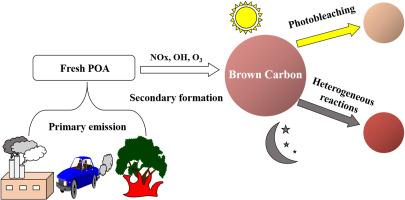基于在线测量的重庆夏季和冬季棕碳气溶胶的光吸收特征及环境效应:二次形成的影响
IF 4.2
2区 环境科学与生态学
Q2 ENVIRONMENTAL SCIENCES
引用次数: 0
摘要
光吸收有机碳(即褐碳,BrC)对大气颗粒中的光吸收和辐射强迫有重要作用。然而,人们对褐碳的二次形成和二次褐碳的光学特性知之甚少。在本研究中,我们分析和评估了重庆地区2022年7月1日至31日(夏季)和2023年1月20日至2月20日(冬季)BrC和二次BrC的光吸收和环境效应。溴化碳和二次溴化碳的光吸收是通过七波长光度计和统计方法估算的。二次 BrC 光吸收的平均值(AbsBrC,sec,λ)占 AbsBrC 的 46.2-56.5%。冬季的 AbsBrC,370 和 AbsBrC,sec,370 分别为 26.2 ± 13.2 和 9.1 ± 5.2 Mm-1,明显高于夏季(分别为 7.2 ± 4.1 和 5.2 ± 3.5 Mm-1)(p <0.001),表明二次形成在 BrC 中起着重要作用。AbsBrC,sec,370的昼夜周期可解释为白天在氧化条件下光吸收发色团的光漂白,以及冬季日落后通过与NH4+和NOx的水反应形成发色团。PSCF分析表明,重庆东北部和东南部地区的人为排放物迁移是冬季PP中二次BrC的重要来源。冬季的 SFEBrC 和 SFEBrC,sec 平均值分别比夏季(64.7 W g-1 和 44.5 W g-1)低 31.9 W g-1 和 27.4 W g-1。相比之下,冬季 SFEBrC 和 SFEBrC,sec 的 J[NO2] 值下降了 23.3% 和 8.7%,高于夏季(19.9% 和 5.6%),这表明 BrC 和次级 BrC 对大气产生了巨大的辐射效应和光化学作用。总之,本研究有助于了解 BrC 的特征和二次形成,准确评估 BrC 在重庆的环境影响。本文章由计算机程序翻译,如有差异,请以英文原文为准。

Characteristics of light absorption and environmental effects of Brown carbon aerosol in Chongqing during summer and winter based on online measurement: Implications of secondary formation
Light-absorbing organic carbon (i.e., brown carbon, BrC) significantly contributes to light absorption and radiative forcing in the atmospheric particles. However, the secondary formation of BrC and optical properties of secondary BrC are poorly understood. In this study, we analyzed and evaluated the light absorption and environmental effects of BrC and secondary BrC from July 1st to 31st, 2022 (summer) and January 20th to February 20th, 2023 (winter) in Chongqing. BrC and secondary BrC light absorption were estimated via a seven-wavelength aethalometer and the statistical approach. The average values of secondary BrC light absorption (AbsBrC,sec,λ) accounted for 46.2–56.5% of AbsBrC. AbsBrC,370 and AbsBrC,sec,370 were significantly higher during winter (26.2 ± 13.2 and 9.1 ± 5.2 Mm−1 respectively) than that during summer (7.2 ± 4.1 and 5.2 ± 3.5 Mm−1 respectively) (p < 0.001), suggesting secondary formation played an essential role in BrC. A diurnal cycle of AbsBrC,sec,370 was explained by the photobleaching of light-absorbing chromophores under the oxidizing conditions in the daytime, and the formation of chromophores via aqueous reactions with NH4+ and NOx after sunset during winter. PSCF analysis showed that transport of anthropogenic emissions from the northeastern and southeastern areas of Chongqing was the important source of the secondary BrC in PP during winter. During winter, the average values of SFEBrC and SFEBrC,sec were 31.9 and 27.4 W g−1 lower than that during summer (64.7 and 44.5 W g−1), respectively. In contrast, J[NO2] values of SFEBrC and SFEBrC,sec decreased by 23.3% and 8.7% during winter higher than that during summer (19.9% and 5.6%), indicating that BrC and secondary BrC cause substantial radiative effects and atmospheric photochemistry. Overall, this study is helpful in understanding the characterization and secondary formation of BrC and accurately evaluating the environmental effects of BrC in Chongqing.
求助全文
通过发布文献求助,成功后即可免费获取论文全文。
去求助
来源期刊

Atmospheric Environment
环境科学-环境科学
CiteScore
9.40
自引率
8.00%
发文量
458
审稿时长
53 days
期刊介绍:
Atmospheric Environment has an open access mirror journal Atmospheric Environment: X, sharing the same aims and scope, editorial team, submission system and rigorous peer review.
Atmospheric Environment is the international journal for scientists in different disciplines related to atmospheric composition and its impacts. The journal publishes scientific articles with atmospheric relevance of emissions and depositions of gaseous and particulate compounds, chemical processes and physical effects in the atmosphere, as well as impacts of the changing atmospheric composition on human health, air quality, climate change, and ecosystems.
 求助内容:
求助内容: 应助结果提醒方式:
应助结果提醒方式:


